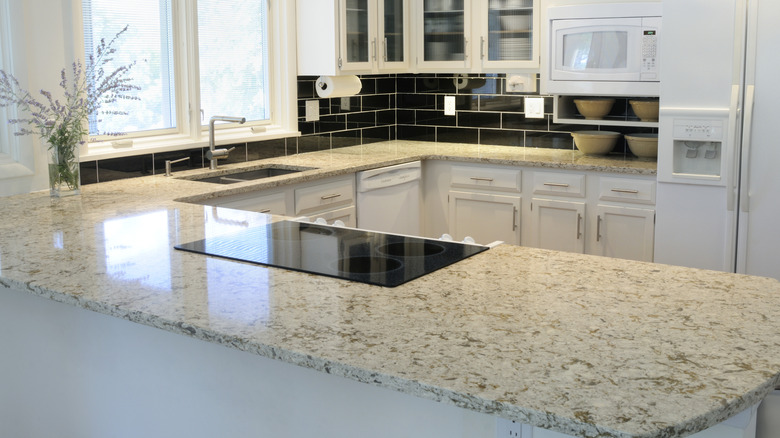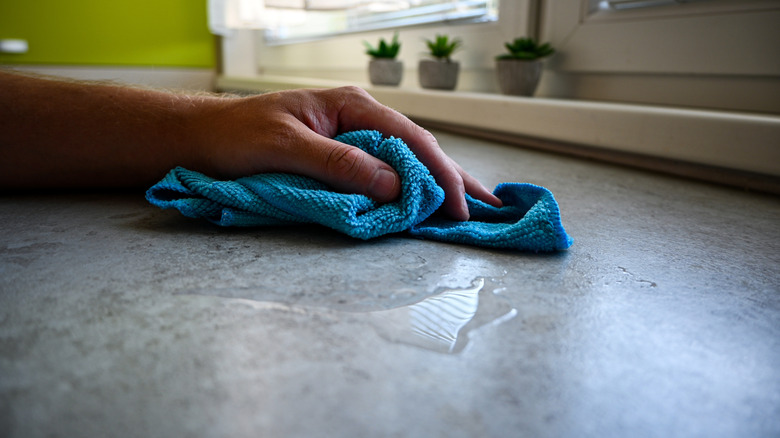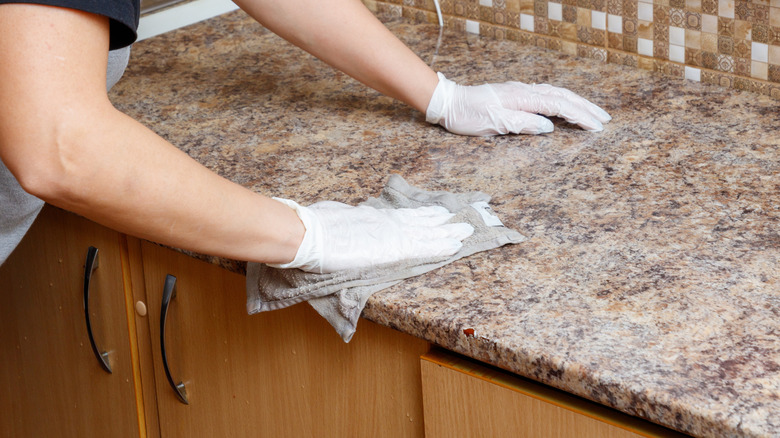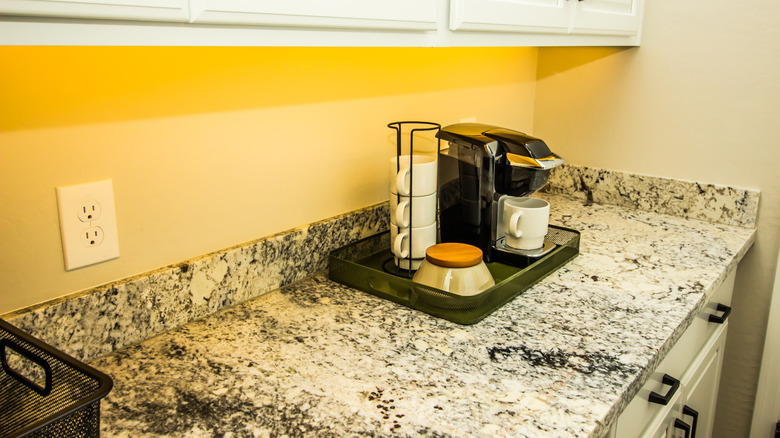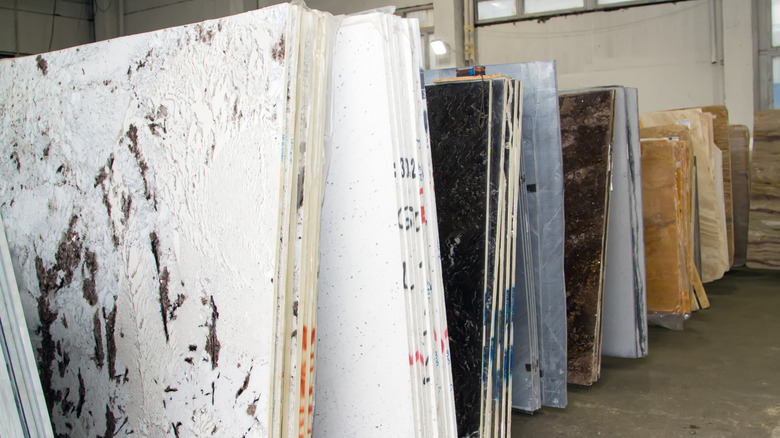Hidden Downsides To Granite Countertops You'll Wish You Knew Before Installing
We may receive a commission on purchases made from links.
Natural stone countertops continue to retain their popularity in residential homes, and granite is no exception. In fact, granite remains a leading choice in kitchen countertops, as well as those in other spaces such as bathrooms and home bars. Unlike human-made stone countertops, granite is completely natural, as it is derived from the rock of the same name. Its colors are comprised of naturally occurring minerals from cooled lava, which also helps create many of the pattern choices you might see. Aside from its natural aesthetics, granite is also praised for its overall style and durability. With the right care, granite can even retain a level of resistance against stains and damage.
The reasons for installing granite countertops in your home are plentiful. As with any countertop selection, though, there are also some downsides to consider. These can range from cleaning techniques and care to possible damage and overall expenses. You'll also want to consider the most common mistakes to avoid when buying granite countertops. This doesn't mean granite should be off-limits entirely. On the contrary, knowing the hidden cons associated with granite countertops can help you make a more informed decision before you invest in this natural stone.
Granite countertops can be expensive
Finding the right countertop materials for your home can arguably come down to pricing. The high costs associated with installing granite countertops can indeed be a downside for any homeowner, especially if you're on a tighter budget. Granite countertops can cost between $40 and $100 for each square foot, with the average cost around $70 per square foot. This is similar to other popular countertop materials such as marble and quartz, but a more expensive option compared with budget-friendly tile and laminate. On top of all of this, you will need to factor in the cost of labor, as granite countertop installation is typically not a DIY kind of project. The exact costs can vary based on location, but may range between $35 and $85 an hour.
Before you give up on your dream of having granite countertops due to cost, you might consider alternatives. One option is to use granite tiles instead of cut slabs, which are significantly less expensive at just $5 to $15 for each square foot. Rather than remodeling all of the countertops in your home, you might also save granite for common areas, such as your kitchen, guest bathroom, and possibly your main bathroom. You might also consider the lifespan of granite. When well-maintained, this stone can last for at least 25 years. This can certainly save you money in the long run, particularly if you're currently residing in your forever home.
Granite may require occasional resealing
Granite slabs that are cut for home countertops are often sealed prior to their installation. The sealant helps to provide a layer of protection over the rock. Without proper sealing, granite is quite porous and might easily become damaged from heat, spills, and wear and tear. This feature is so important that some manufacturers even apply what is referred to as a "lifetime seal" on their granite countertops, which means these can last for over a decade or longer without having to reseal them.
If you know for certain that your granite countertop came with a lifetime sealant, this means you may not have to worry about resealing it for years to come. On the other hand, other types of sealants will require you to occasionally reseal your countertops to protect them from damage. This should be done as often as several times a year with the help of a commercial sealant such as the Weiman Granite and Stone Sealer. You might consider adding a reminder on your calendar to check your sealant on a regular basis. One simple way to tell if it's time to reseal your stone countertops is the water test. Place a few drops of water onto a clean countertop to see whether the old seal has worn away. If water drops bead up on the surface, the sealant is in good shape for now. However, you should consider resealing the countertop if the water does not bead during this test.
Granite requires careful cleaning and maintenance
When granite is properly sealed, this creates an additional layer of protection against splatters and spills from food, water, and cooking oils. In order to protect granite and its sealant, though, you will need to clean up these types of spills as soon as they occur. This is especially the case with anything acidic, such as tomato sauce, lemon juice, coffee, and wine, as they can stain or damage the surface.
A lack of a cleaning schedule is arguably the leading cleaning mistake everyone makes with granite countertops. At the bare minimum, you will need to blot up spills as they happen and wipe your countertops down with a wet soapy cloth or paper towel. For caked-on messes, you will need to use a stronger cleaner. With that said, you can't use just any cleaning product. Some common commercial cleaners, such as bleach and Windex, are certainly off-limits, but even seemingly innocuous "natural" cleaners can harm granite countertops as well. In particular, you should never use white vinegar or anything citrus-based, which can damage granite over time and dull the finish.
With this in mind, you may need to consider investing in specialized granite cleaners as the safest method to keep granite maintained. Keep a safe and effective product on hand, like Weiman Disinfectant Granite and Stone Clean and Shine. The biggest downside here is that the expense of these cleaners can add up — but without them, you could risk damaging an already-pricey countertop material.
Despite its durability, granite may chip and crack
Aside from aesthetics, one of the main reasons homeowners choose granite over other countertop materials is because of the stone's reputation for durability. This may be especially appealing if you like cooking at home on a regular basis, or if you have children who might naturally cause more wear and tear around kitchen and bathroom countertops. With that said, granite is not 100% durable. One of the biggest contributors to damage in granite is the natural breakdown of its sealant, which can be fixed with occasional resealing.
Even when sealed, you will need to treat granite countertops with care to help prevent chips and cracks that might otherwise lead to permanent damage. This means you cannot simply throw heavy items on top of your counters, or scrape pots, pans, and metal utensils against their surface. You also cannot place hot items on the stone, as these may cause the slabs to warp and crack over time. While perhaps these rules seem pretty straightforward, it can be stressful if you have frequent guests or young children who might not be as careful.
You can also help prevent granite countertop cracks by making sure the slabs are professionally installed from the get-go. Attempting to save money by installing granite countertops yourself could ultimately lead to unlevel surfaces that might flex and eventually fracture. If you do decide to take the DIY path, take careful and precise measurements.
Certain granite countertop styles may quickly make your home look dated
While granite countertops have remained popular for many years, it's important to keep in mind that countertop trends do come and go. If you want the newest and latest countertop trend in your own home, granite may not be the way to go. In fact, quartz and quartzite are quickly taking over granite in terms of trendiness. While the ultimate decision is really up to you and not what is currently on trend, you might still need to consider this point if you plan on putting your place on the market within the next couple of years.
It's worth noting that granite itself might not be totally dated, but certain styles can make your home look older. This is especially true of colorful patterns made with dark browns, yellows, and reds, as well as anything of a particularly bold hue. Speckled designs are another dated granite countertop style that won't be making a comeback anytime soon. Homeowners are still installing granite, but they are opting for more muted and natural colors instead. These include those made with mixtures of whites, grays, and charcoal. As you peruse samples of granite, you will want to bear all of this in mind before your newly installed countertop instantly ages your kitchen.
